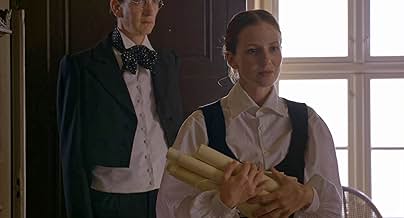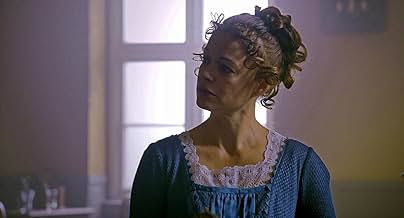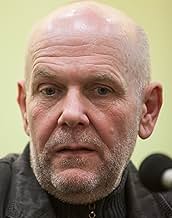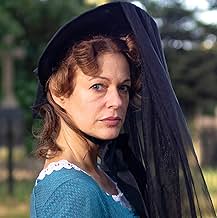Effigie - Das Gift und die Stadt
- 2019
- 1h 25min
VALUTAZIONE IMDb
7,2/10
3940
LA TUA VALUTAZIONE
Aggiungi una trama nella tua lingua1828 in the German port city of Bremen: A female law clerk tries to prove her worth during the investigation of a series of poisonings.1828 in the German port city of Bremen: A female law clerk tries to prove her worth during the investigation of a series of poisonings.1828 in the German port city of Bremen: A female law clerk tries to prove her worth during the investigation of a series of poisonings.
- Regia
- Sceneggiatura
- Star
- Premi
- 29 vittorie e 22 candidature totali
Recensioni in evidenza
Deftly filmed by director Udo Flohr, "Effigy - Poison and the City" offers an absorbing glimpse of history that should satisfy period drama fans. Set in the 19th-century German port city of Bremen, the film is based on the true story of Gesche Gottfried. As one of the first female serial killers ever identified, she was beheaded in 1831 - Bremen's last public execution.
The movie skilfully blends elements of suspense, drama, and psychological thriller, keeping the audience engaged and intrigued throughout. Its meticulous attention to historical detail immerses viewers in the era's atmosphere. The pacing is deliberate - and occasionally slow, but this apparent mundanity underscores the grim brutality of its subject matter.
Lead actress Suzan Anbeh, who portrays Gesche Gottfried, delivers a nuanced and compelling performance, expertly balancing the character's complexity and evoking both empathy and revulsion. She presents Gottfried not just as a villain but as a multifaceted individual shaped by her circumstances and demons. Consequently, the film also delves into themes of gender and societal roles, reflecting on how women were perceived and treated during that time. It offers both entertainment and insight.
Overall, if you're a fan of thought-provoking psychological thrillers and period pieces alike, give Effigy a watch.
The movie skilfully blends elements of suspense, drama, and psychological thriller, keeping the audience engaged and intrigued throughout. Its meticulous attention to historical detail immerses viewers in the era's atmosphere. The pacing is deliberate - and occasionally slow, but this apparent mundanity underscores the grim brutality of its subject matter.
Lead actress Suzan Anbeh, who portrays Gesche Gottfried, delivers a nuanced and compelling performance, expertly balancing the character's complexity and evoking both empathy and revulsion. She presents Gottfried not just as a villain but as a multifaceted individual shaped by her circumstances and demons. Consequently, the film also delves into themes of gender and societal roles, reflecting on how women were perceived and treated during that time. It offers both entertainment and insight.
Overall, if you're a fan of thought-provoking psychological thrillers and period pieces alike, give Effigy a watch.
It's astonishing that I only discovered this film today. "Effigy: Poison and the City" revolves around two formidable women who deliver incredibly convincing performances at the heart of this true story.
If the character of the murderess and her plot had been fictional, it would have strained credibility; it would have felt excessively dramatic. What makes it unsettling is that this seemingly mild-mannered yet cunning woman, who poisoned approximately 15 people over several years before her capture, actually existed in Bremen.
In the movie, the murderer appears to covet the talents and social status of her adversary, the young law clerk Cato Böhmer. While there are a few plausible interpretations of the killer's motives and psychological makeup, for the most part, her actions remain shrouded in mystery. This leaves you with plenty to contemplate afterward. It's a genuinely thought-provoking and highly entertaining experience.
If the character of the murderess and her plot had been fictional, it would have strained credibility; it would have felt excessively dramatic. What makes it unsettling is that this seemingly mild-mannered yet cunning woman, who poisoned approximately 15 people over several years before her capture, actually existed in Bremen.
In the movie, the murderer appears to covet the talents and social status of her adversary, the young law clerk Cato Böhmer. While there are a few plausible interpretations of the killer's motives and psychological makeup, for the most part, her actions remain shrouded in mystery. This leaves you with plenty to contemplate afterward. It's a genuinely thought-provoking and highly entertaining experience.
10gareth33
The film's foundation in a true story significantly and it really impacted my admiration for it. Kudos for adeptly and artistically presenting the narrative with a robust feminist perspective. The custom-composed film score, executed by a 40-piece orchestra, is masterfully crafted and seamlessly aligns with the overall film ambiance. While not adhering to a modest budget, this isn't your typical Hollywood production, demanding your focused engagement. However, the investment is undeniably rewarding, even for those who aren't typically drawn to historical dialogues. Encountering films like this isn't a frequent occurrence, so I'm genuinely pleased to have come across it. I'll definitely make a point to recommend it to my family and friends.
Two strong women play convincing roles in the foreground of this real life story.
If the murderess and her plot had been invented, this would hardly be credible, it would simply appear overdone. So the disturbing thing is that this apparently gentle but crafty woman, who poisoned around 15 people over several years before being caught, really existed in Bremen. I watched the film in a cinema in a city in Germany, not far from Bremen, and friends from there know the story from local history.
In the film, the murderess appears to envy the skills and social standing of her opponent, the young law clerk Cato Böhmer.There are a few understandable interpretations of the killer's motivation and psychological disposition, but by and large her actions remain a mystery, so you get something to ponder about afterwards. Why did she kill so many people and at the same time portray herself as a caring person?
The dialogues are enjoyable acoustically, in contrast to many current films, where it is apparently cool to mumble or to accompany the dialogues with loud background noises or music.
The specially produced film music, performed by a 40-piece orchestra, is wonderfully composed and fitting to the whole atmosphere of the film.
The criminal case is integrated into the technical and economic developments of the era around 1830. You learn about railroad construction in Northern Germany together with impressive historical backdrops. As an interesting detail, the use of a kind of mechanical copier is also shown (a device completely unknown to me).
It is a film well worth seeing, not only for fans of historical dialogues. I am already waiting for the next film from Udo Flohr and hope that he will continue to employ such powerful actors.
If the murderess and her plot had been invented, this would hardly be credible, it would simply appear overdone. So the disturbing thing is that this apparently gentle but crafty woman, who poisoned around 15 people over several years before being caught, really existed in Bremen. I watched the film in a cinema in a city in Germany, not far from Bremen, and friends from there know the story from local history.
In the film, the murderess appears to envy the skills and social standing of her opponent, the young law clerk Cato Böhmer.There are a few understandable interpretations of the killer's motivation and psychological disposition, but by and large her actions remain a mystery, so you get something to ponder about afterwards. Why did she kill so many people and at the same time portray herself as a caring person?
The dialogues are enjoyable acoustically, in contrast to many current films, where it is apparently cool to mumble or to accompany the dialogues with loud background noises or music.
The specially produced film music, performed by a 40-piece orchestra, is wonderfully composed and fitting to the whole atmosphere of the film.
The criminal case is integrated into the technical and economic developments of the era around 1830. You learn about railroad construction in Northern Germany together with impressive historical backdrops. As an interesting detail, the use of a kind of mechanical copier is also shown (a device completely unknown to me).
It is a film well worth seeing, not only for fans of historical dialogues. I am already waiting for the next film from Udo Flohr and hope that he will continue to employ such powerful actors.
The fact that this movie draws its inspiration from actual events significantly enhanced my enjoyment and appreciation of it. The filmmakers deserve commendation for their ability to present a narrative that not only engages but also incorporates a strong feminist perspective, executed both artfully and convincingly. The performances were exceptional, particularly those of the actress portraying the female serial killer and her counterpart, the nemesis character. Their portrayals were both compelling and immersive, adding depth to the storyline.
Additionally, the music score of the film was a standout feature. It complemented the mood and tone of the movie beautifully, weaving seamlessly with the narrative to enhance the overall experience. On the other hand, the subplot, which aimed to enrich the film by providing political context, fell somewhat short for me. Although it was an interesting addition, I found it somewhat elusive and challenging to fully grasp as an average viewer. This aspect didn't diminish my overall enjoyment of the film but was a noticeable contrast to the otherwise engaging storytelling.
Looking forward, I am genuinely excited and eagerly anticipating more work from the director, Udo Flohr. His unique approach to storytelling and his ability to bring complex characters to life are truly commendable, and I am keen to see how his future projects unfold.
Additionally, the music score of the film was a standout feature. It complemented the mood and tone of the movie beautifully, weaving seamlessly with the narrative to enhance the overall experience. On the other hand, the subplot, which aimed to enrich the film by providing political context, fell somewhat short for me. Although it was an interesting addition, I found it somewhat elusive and challenging to fully grasp as an average viewer. This aspect didn't diminish my overall enjoyment of the film but was a noticeable contrast to the otherwise engaging storytelling.
Looking forward, I am genuinely excited and eagerly anticipating more work from the director, Udo Flohr. His unique approach to storytelling and his ability to bring complex characters to life are truly commendable, and I am keen to see how his future projects unfold.
I più visti
Accedi per valutare e creare un elenco di titoli salvati per ottenere consigli personalizzati
- How long is Effigy: Poison and the City?Powered by Alexa
Dettagli
- Data di uscita
- Paesi di origine
- Siti ufficiali
- Lingue
- Celebre anche come
- Effigy: Poison and the City
- Luoghi delle riprese
- Mecklenburg, Germania(location)
- Azienda produttrice
- Vedi altri crediti dell’azienda su IMDbPro
Botteghino
- Budget
- 485.000 USD (previsto)
- Tempo di esecuzione1 ora 25 minuti
- Colore
- Mix di suoni
- Proporzioni
- 1.85 : 1
Contribuisci a questa pagina
Suggerisci una modifica o aggiungi i contenuti mancanti
























